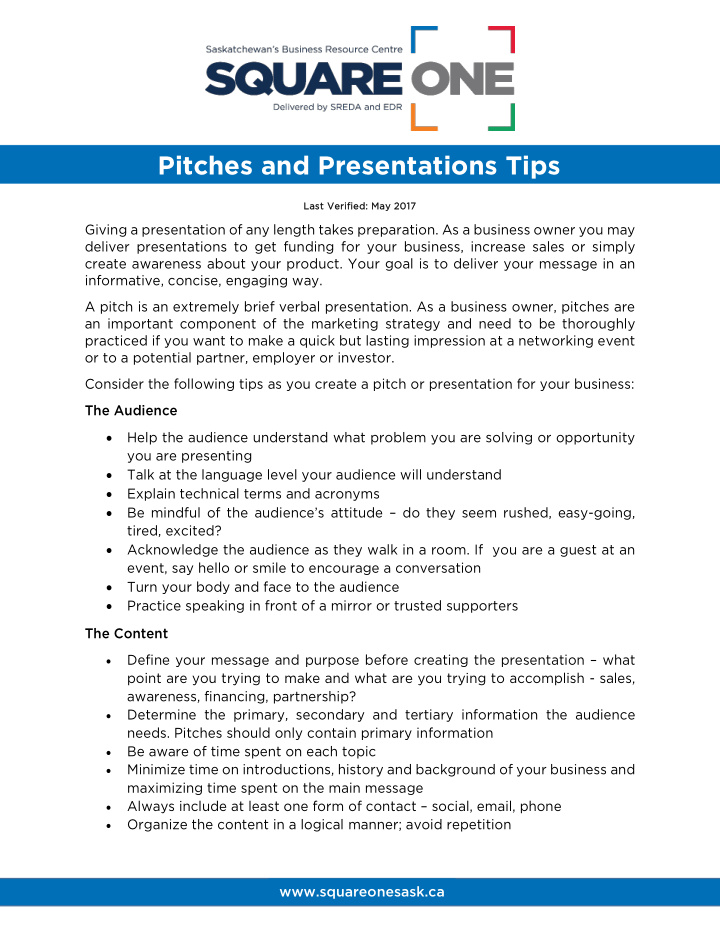



Pitches and Presentations Tips Last V Ver erified ed: May 20 2017 Giving a presentation of any length takes preparation. As a business owner you may deliver presentations to get funding for your business, increase sales or simply create awareness about your product. Your goal is to deliver your message in an informative, concise, engaging way. A pitch is an extremely brief verbal presentation. As a business owner, pitches are an important component of the marketing strategy and need to be thoroughly practiced if you want to make a quick but lasting impression at a networking event or to a potential partner, employer or investor. Consider the following tips as you create a pitch or presentation for your business: The Audience • Help the audience understand what problem you are solving or opportunity you are presenting • Talk at the language level your audience will understand • Explain technical terms and acronyms • Be mindful of the audience’s attitude – do they seem rushed, easy-going, tired, excited? • Acknowledge the audience as they walk in a room. If you are a guest at an event, say hello or smile to encourage a conversation • Turn your body and face to the audience • Practice speaking in front of a mirror or trusted supporters The Content • Define your message and purpose before creating the presentation – what point are you trying to make and what are you trying to accomplish - sales, awareness, financing, partnership? • Determine the primary, secondary and tertiary information the audience needs. Pitches should only contain primary information • Be aware of time spent on each topic • Minimize time on introductions, history and background of your business and maximizing time spent on the main message • Always include at least one form of contact – social, email, phone • Organize the content in a logical manner; avoid repetition www.squareonesask.ca
• action. Con onclude you your p r pre resen entatio ion w wit ith a a c compellin elling c call t ll to a Supporting Aids • Use a short, meaningful story to humanize yourself to the audience • Use statistics or specific examples to reinforce your point • Bring samples if you're selling a product or prototypes • Use testimonials if you are pitching a service • Use images and visuals to emphasize the message • Slides or digital aids are helpful but keep them as simple as possible • Keep text on visual aids to a minimum • Ensure your branding and desired image is consistent with what the audience sees and feels • Talk with individuals at a breaks, before and after the presentation to create a climate for follow up and sales. Questions • Ask for clarification if you feel you don’t understand questions • Avoid saying “like I said” as this indicates you think they audience wasn’t listening • Prepare questions to answers you anticipate questions your audience may ask • Allowed clarifying questions to interrupt and be answered immediately • Questions asked to help solve a certain problem should be referred either to a question and answer period or to a private discussion at a later time • It is also a good idea to repeat questions from the floor to make sure that both the question and your answer are heard by the whole audience Venue • Ensure you voice will carry to the farthest point of where your audience is • Rent a microphone if necessary • Check and double-check your equipment • have a contingency plan in case of a technical malfunction • Arrive early to avoid traffic delays, set up and gather your thoughts before presenting • Keep the lights on. You could turn off the lights in the immediate area of the presentation for screen contrast www.squareonesask.ca
Perfect Is Not Possible Even with the best preparation, sometimes equipment will fail, attendees will not show and contingency plans are needed. Be prepared for setbacks without blame, fuss or apology at any given moment. Try to keep the momentum, enthusiasm and the interest on the presentation. Some presentations, like your pitch, should be second nature that you will be able to present on-demand at any time. You’ll find that you change your pitch ever so slightly for your audience. Eventually your preparation time will decline and you will speak about your business confidently. www.squareonesask.ca
The individual/business/corporation/partnership (hereinafter referred to as the client) acknowledges and understands that Square One does not warrant or represent the accuracy, suitability or applicability of this information and assumes no responsibility or liability for the use thereof by the client and any third parties and that the interpretation, use and application of such information shall be the client's sole responsibility. Disclai aimer Information contained in this document is of a general nature only and is not intended to constitute advice for any specific fact situation. Users concerned about the reliability of the information should consult directly with the source, or seek legal counsel. Lin inks P Polic icy Hypertext links may lead to non-federal government sites which are not subject to the Official Languages Act and the material is available in one language only. For more information, contact Square One www.squareonesask.ca
Recommend
More recommend